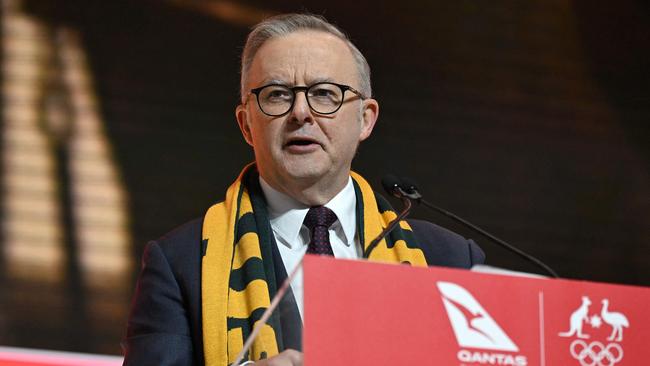
Peter Dutton has delivered sharp rhetorical blows over Labor’s high spending and immigration failures, but little in the way of what the alternative government stands for – except for the gormless junk policy he has pitched to remind the faithful he’s a warrior. So far, outside the daily skirmishes, pitches on government-owned nuclear power plants, cutting the permanent migration intake and forcing grocery giants to divest stores are the sum of the Coalition’s policy creativity.
Neither side is offering an economic reform plan, although there is general housekeeping and busywork on Labor’s part, given its control of the lower house. But as one former prime ministerial adviser tells Inquirer, the private sector is in trouble and our future living standards are imperilled.
“We now have a fundamental problem in that neither side of politics has a regard for the private economy – for business as the main employers of Australians or for the value of market instruments – and neither side cares about debt reduction in any meaningful way,” the source says.
“The feel in the economy is not great and palpably smells of fear. We are missing a policy focus on how to create the right conditions for business to have the confidence to invest for growth.”
This week the Committee for Economic Development of Australia launched a dashboard that reveals how we are faring as a nation and explores the key risks to future success. CEDA’s chief executive Melinda Cilento says after early action in important areas, the Albanese government “now appears to be going slow on some vital and electorally sensitive policies”.
Cilento points to the short-term policy cycle “where we identify the same problems, come up with the same solutions, get bogged down in consultation and implementation, and nothing changes”.
“Whether it’s a housing crisis decades in the making, stagnant productivity, the inadequacy of welfare payments and support, tax reform or our inability to close the gap on Indigenous life outcomes, Australia seems stuck in the face of both significant challenges and opportunities,” she says.
CEDA’s new digital tool maps strengths, weaknesses, opportunities and threats to prosperity, sustainability and equality. The public policy think tank warns “cracks are emerging” and is worried about the mental health crisis and poor education outcomes, both of which have been well documented this week, respectively, by Natasha Robinson and Natasha Bita.

I’ll focus on two enduring economic weaknesses: housing affordability and lagging productivity.
During the past 30 years the ratio of home prices to household incomes has doubled. Across that period, the time to save for a home deposit has also doubled, from five to 10 years.
The Reserve Bank, which has raised the cash rate 13 times since May 2022, calculates the share of household disposable income to service outstanding mortgage debt is a record 10 per cent.
There’s a lot behind this homegrown misery, particularly afflicting those under 35 whose home ownership rates are about 10 percentage points below their parents’ at the same stage of life. A rolling maul of factors are at play, such as cheap money, tax concessions and our bunching in a few coastal cities.
As AMP chief economist Shane Oliver has explained, it’s the failure of housing supply to meet a surge in demand that has been the main driver of poor affordability. Rampant population growth, fed by record post-pandemic migration, has exacerbated the housing shortfall.
Because of compromised supply capacity, last year Oliver called for a cut to migration to 260,000 (a level the government believes we’ll achieve this year, which is ambitious given that would require a halving from the 2023-24 inflow). Other experts want a migration pause to catch up on housing.
A new paper by David McCloskey and Bob Birrell for The Australian Population Research Institute shows that for Sydney and Melbourne, migrants are by far the largest source of growth in demand for rental accommodation, as well as the main source of demand for detached houses, though with a lag of around 10 years after arrival. Developers, they say, cannot make a profit from affordable high-rise or medium-density apartments, the latter because of site costs.
“Our analysis shows that densification is not working and is unlikely to work in the near future,” Birrell tells Inquirer. The authors argue opening up more housing on city fringes is the only realistic option in the short term but is being stymied by state governments determined to stall fringe growth.
In her home town of Armidale in NSW last week, RBA governor Michele Bullock said: “Housing supply is a very slow-moving thing and when you get a big increase in demand, which you do with migration, you end up obviously with pressure on housing prices and rents.” Yet it’s not the whole story. Household size has declined.

“People who used to perhaps have a few flatmates now think no, I want a spare room,” Bullock said. “And as the population ages, children move out, my house is one example, a big four-bedroom house and two people living in it. That adds to the demand for the stock of housing and the supply side isn’t responding quickly enough.”
The Albanese government is aiming for 1.2 million new homes across five years. The “build” is moving slowly and critics argue Labor’s plan is geared to social and affordable housing, a small part of the supply story. The Housing Industry Association demands a policy reset to fix supply “across the entire housing continuum”. “The current agenda is in danger of being too narrow and does not sufficiently go to the heart of the problem of fixing housing supply for future generations,” says HIA managing director Jocelyn Martin.
In its liaison, the RBA has heard that most builders of new detached homes expect their workload to slow as they complete their backlog of projects; weak sales during the past 18 months, because of buyers’ concerns about high prices and interest rates, mean fewer new builds.
The outlook for apartment construction is grim. Many developments are on hold, the RBA’s industry contacts said, due to rising costs and difficulty in getting tradies. “This is particularly the case for high-density projects that compete for labour with similar skills to those required by the large volume of infrastructure projects,” the latest statement on monetary policy said. “Contacts also attribute higher construction costs to a decline in productivity, construction delays and the higher cost of finance.”
Our abysmal productivity performance is an old story but no less critical, especially given stagnant growth in living standards and the pressure that rising nominal wages are feeding into labour cost escalation, which will make it harder for the RBA to meet its inflation target.
Labor is having a decent crack at reviving competition policy but is on a go slow with an integrated productivity plan. Its workplace changes are a retrograde step.
Albanese’s signature Future Made in Australia move is risky. Productivity Commission chairwoman Danielle Wood has warned the industry policy would divert investment from more productive parts of the economy and lead to higher-than-necessary costs for taxpayers. Maybe even forever subsidies, without an appropriate exit strategy, she said in April.
As OECD division head of growth, competitiveness and regulation Dan Andrews has shown, the productivity gap between global frontier firms and Australian firms has grown over time. Local firms catch up to the global frontier more slowly than previously, suggesting slower adoption of cutting-edge technologies and processes
Andrews says “there is a need to revitalise the foundations for growth” in Australia.
“Nowhere is the problem more apparent than the rising regulatory burden, which is sapping the vitality of the business sector,” the expat Australian productivity sage tells Inquirer, citing the Paris-based body’s product market regulation index, which measures the barriers to firm entry and competition.
Australia ranks a mediocre 24th out of 43 OECD nations; in 2003, we were on the podium with a bronze medal. The problem is especially acute in the “red tape” that is hindering business creation, where Australia ranks 35th among advanced countries.
Andrews says Labor’s attempts to revive National Competition Policy “are a step in the right direction but there’s so much more we can do”. CEDA sees “a culture among business and government that has, over time, become more focused on the short term and risk averse”. Is Albanese simply waiting for an opening to launch a second-term agenda that will address these critical areas of national lethargy?
In 2022, Labor offered a modest policy buffet, plus an assault on the incumbent’s character. Albanese declared he would be “kicking with the wind in the final quarter”. This time he’ll also need to rack up more contested possessions and kick even straighter if he is to win more than one-third of the primary vote.






The siren will soon sound to end the third quarter in Anthony Albanese’s first term of government. That’s assuming the Prime Minister decides to go the full distance between polls. In a policy sense, the coming contest looks clear: who can best address voters’ living costs, as well as future challenges, including the energy transition to net zero by 2050, housing supply, budget repair and the provision of services to an ageing population.